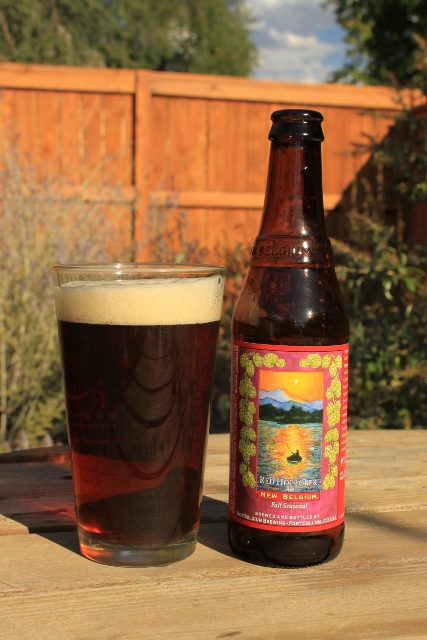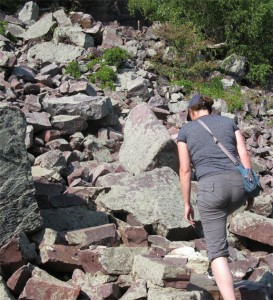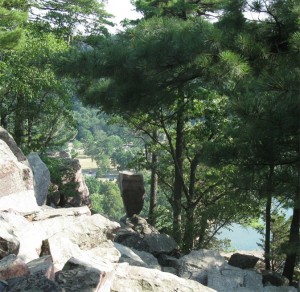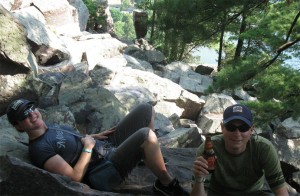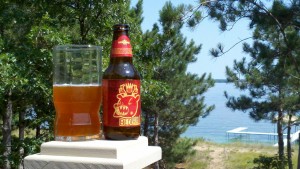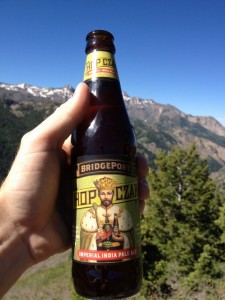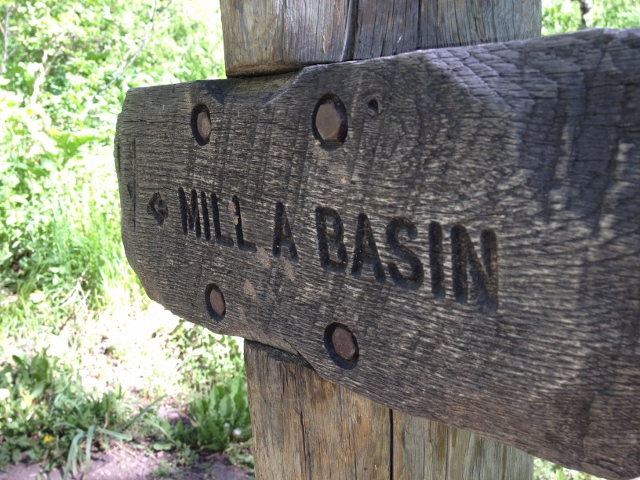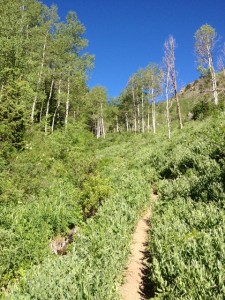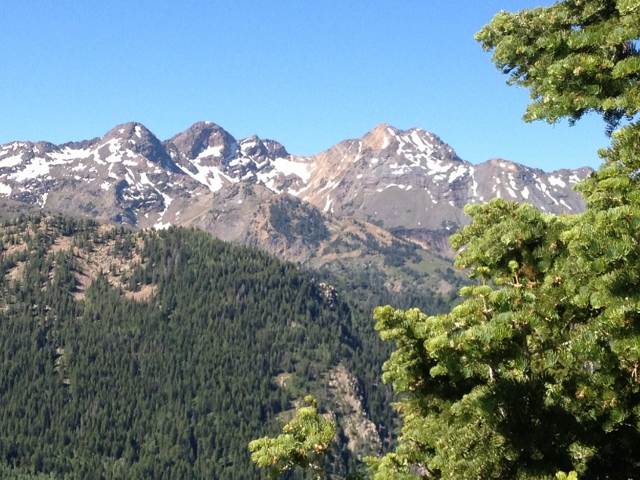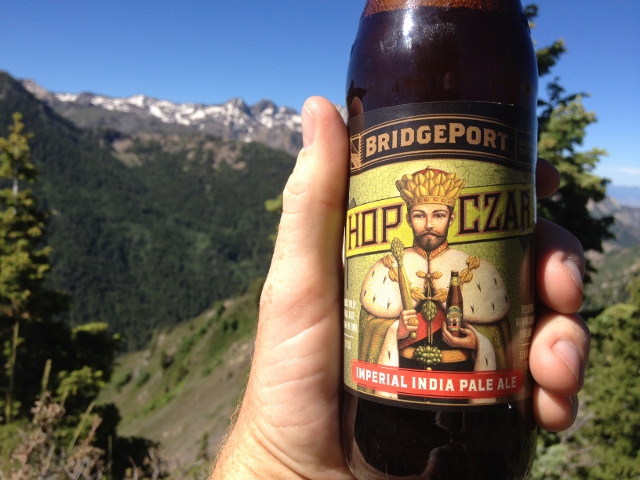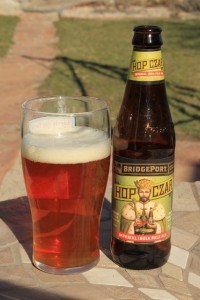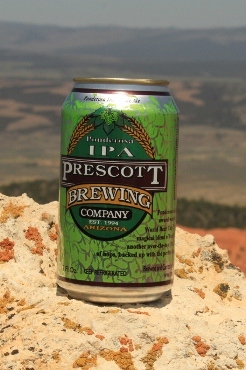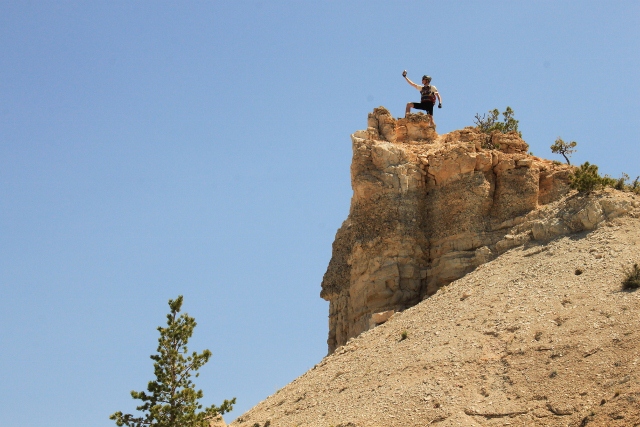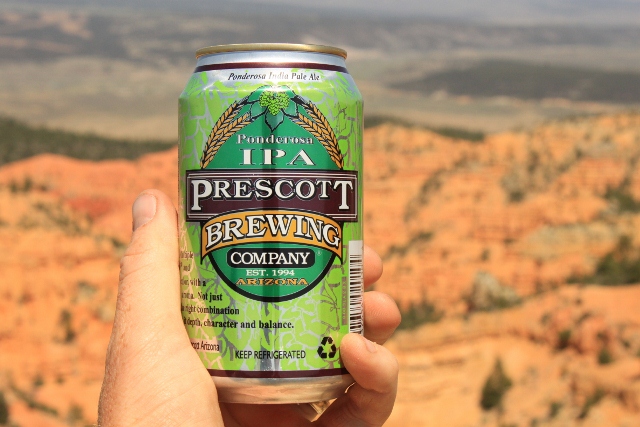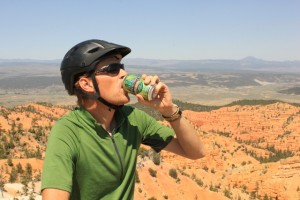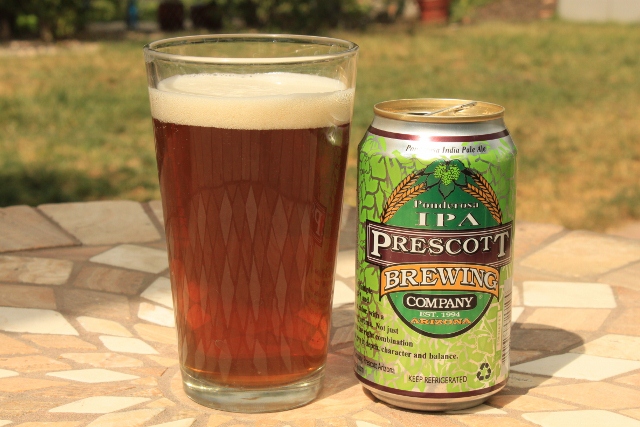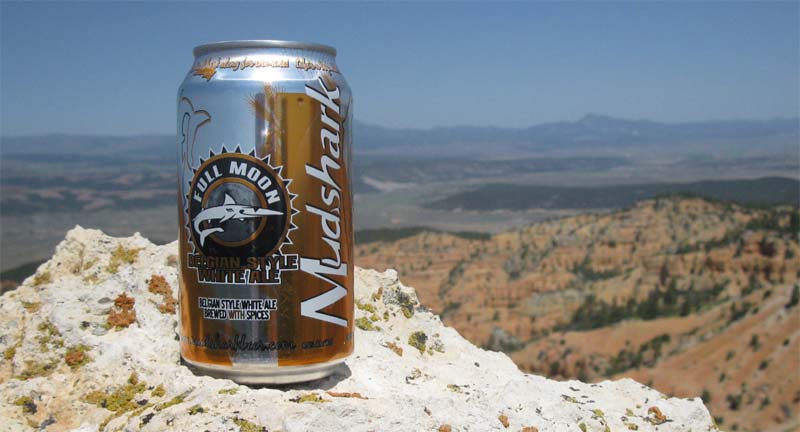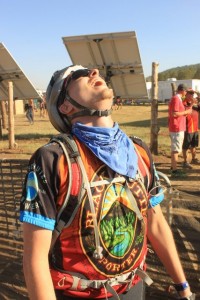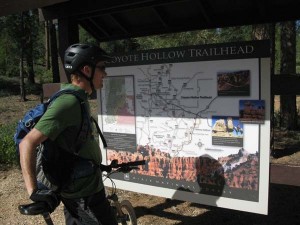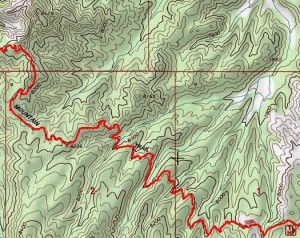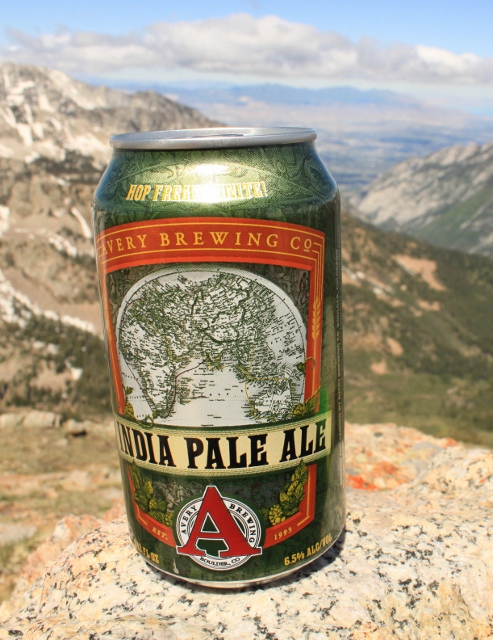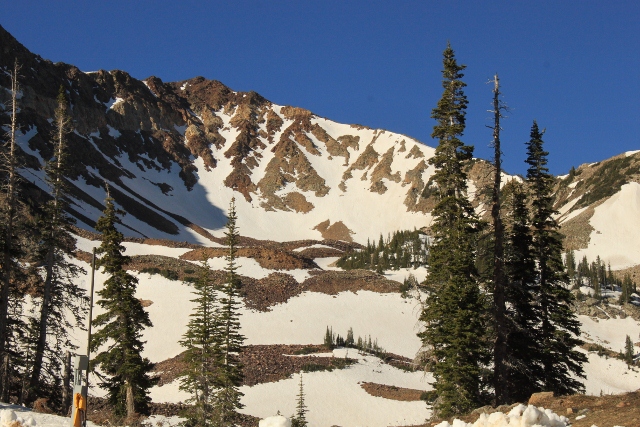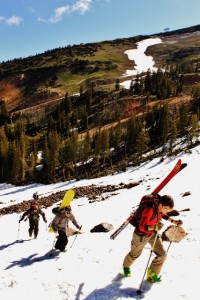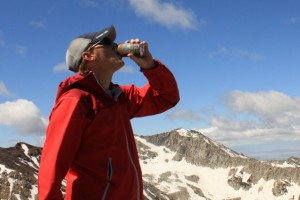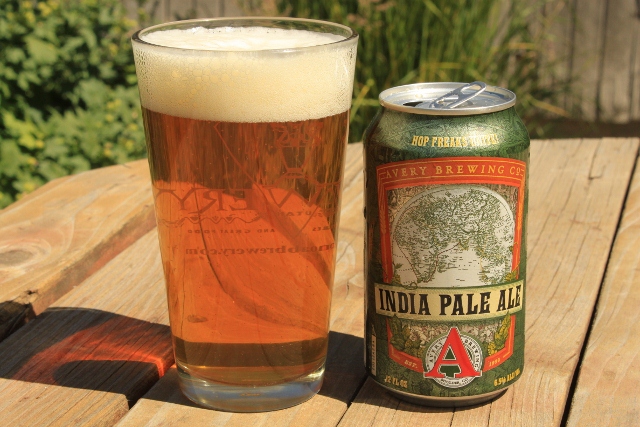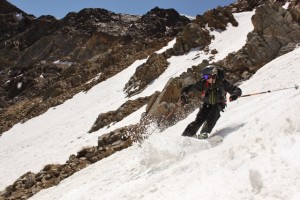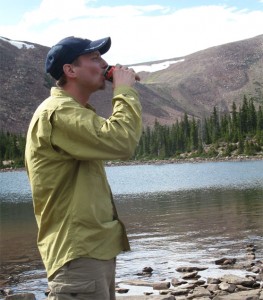
Enjoying a SanTan Devil’s Ale high in the Uinta mountains.
Minimal seems to be the theme in outdoor recreation. Nowhere has the minimal fad done more to benefit the outdoor enthusiast than in backpacking. Over the past few years, through various upgrades and refinements, I have winnowed weight from my pack: a down sleeping bag that is a pound lighter than the old, a new tent that’s half the weight of my previous, “cook in the bag” freeze dried dinners that only require boiling water; it all adds up (or more correctly subtracts up)– in theory! What unfortunately has happened as a consequence of the weight reduction is that I’ve replaced most of that weight with less nessessary items like a pair of water shoes for stream crossings, a mosquito net, a hammock, etc. With all that taken into account, it still seems impossible for me to keep my pack under 40 pounds. So when I loaded my Osprey at the Swift Creek Trailhead in the Uintas, a 12 ounce can of pale ale seemed like a minor addition considering the weight I already had on my back. The thought of that beer in my pack and the promise of drinking it amongst Utah’s highest peaks would mentally lighten the burden I’d be carrying up to Farmer’s Lake.
Just east of the Wasatch Front, the Uinta Mountains gradually bulge up between the northern border with Wyoming and the Duchesne River to the south in a crumbled and rounded east-west spine. The Uinta’s aren’t about “purple mountain majesty” or jaw dropping views like you get in some ranges like the Tetons or Sawtooths, instead, the Uinta’s are about one thing… altitude.

Looking up Swift Creek Canyon. Farmer’s Lake is to the left of the divide at the back of the picture.
With over 20 peaks surpassing 13,000’ in elevation, the Uintas are a destination for many Salt Lake hikers. For backpackers and day hikers seeking a change from the Wasatch, driving along the Mirror Lake Highway or camping at the more distant Henry’s Fork near Kings Peak can make for a rewarding, long weekend. However, the Uinta’s can contain two annoyances: national park size throngs of people and mosquitos. Still, the sprawling mountain range does have some lesser known areas where you can cut down on at least one of those pests. One of those areas is the Yellowstone Creek drainage north of Duchesne where The Connoisseur and I set out for a two night pack trip along the Swift Creek Trail.
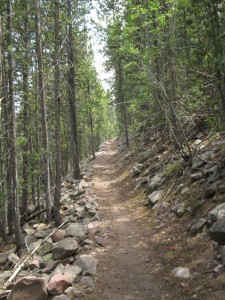
The early miles of the trail are narrow and choked with lodgepole pine.
The Swift Creek Trail wasted no time in taxing our legs and bringing a sweat to our brow. Immediately ascending a ridge that separates Swift from Yellowstone Creek before they converge near the trailhead, we soon found ourselves on a great vantage point. Each creek has a corresponding trail and where the gently ascending Yellowstone trail stays level with its namesake creek for most of the hike and eventually reaches the western side of Kings Peak, the Swift Creek trail spends very little time near the watercourse. Upon reaching a burnt ridgetop that’s visible from the trailhead, we crossed over to the east side and continued climbing with not a sight of water since the bridge near the trailhead. The first mile gained almost 1,000’ and I realized our late departure of 5:30 pm may have some positive consequences. With the suns rays now on the opposite side of the ridge, we had some slight sanctuary from the heat. While we hiked high on the ridge, the creek could barely be seen below us through the thickets of lodgepole that clung to the steep walls of the canyon. Further up the canyon, the large mass of Uinta rock that creates the eastern border of the Farmer’s Lake Basin, our destination, hulked above the green carpet of pine that blanketed the hills. Around 2.5 miles traveled, the trail began descending down to Swift Creek. Aspens popped up with more frequency and the raging torrent of the creek could be heard flowing over boulders and deadfall to create a serene setting in the soft evening light. The canyon widened slightly here and the creek’s current began to slack as beaver dams created numerous trickles and ponds that filled the marsh. After a creek crossing, we found some higher ground clear enough to camp and called it a day after 3 hours of hiking.
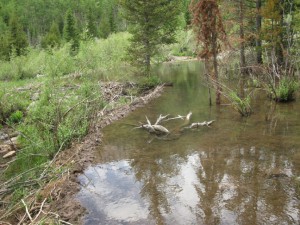
The work that beavers can do.
The next morning’s hike started with a fairly flat track through small grassy meadows and marshes where I marveled at the gardens of jagged thin aspen stumps pruned down by the beavers. Not long after a second stream crossing, the trail made its second major climb. A mile of switchbacks would lead us to Deer Lake at 10,260’. On this stretch, the heat began to take its toll as a steep grade accompanied the added obstacles of rocks and numerous downed trees. Upon reaching Deer Lake around 10am we saw evidence of manmade water control. While less of a natural wonder than the beaver ponds below, it was still no less impressive to see the extensive riprapping and damming that was done by farmers in the early 20th century. Deer Lake signaled the end of the grueling part of our hike, but our destination still lay over 3 miles away. Down below, at our last stream crossing, we had left the path of Swift Creek, (which continues on to Timothy Lake), and were high on the wall of the canyon looking over at the Uinta giant of Mt. Emmons, the 4thhighest peak in the Uintas.
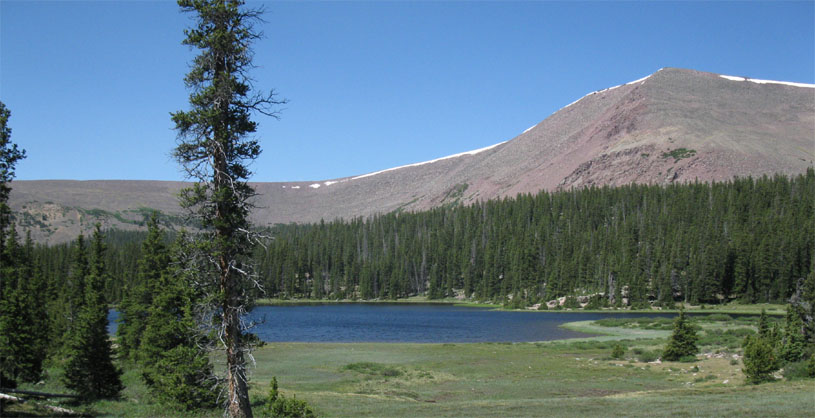
Just below Farmer’s Lake, White Miller is a destination in and of itself.
Skirting around the east side of Deer Lake, we gradually walked through talus fields and past unnamed lakes before reaching White Miller Lake in a basin below Farmer’s Lake. At the north end of that lake, the trail became difficult to follow as the trail disappeared into the soft, wet marsh. Rather than backtrack to the trail, we cross-countried along the slopes below Farmers Lake and eventually came out on the shore of the large alpine lake.
Farmer’s Lake looms pretty large, especially at a height of nearly 11,000’; probably the largest lake I’ve seen at that elevation. In 2006, the Uinta Basin Replacement Project returned the lakes in this area to a more natural level by removing the ancient headwalls once placed by the turn of the century farmers. The project stabilized the water level at a “no hazzard” depth. Rather than trying to control many lakes in such a remote area, the water is now stored well downstream in the Big Sand Wash Reservoir and consequently, the lakes seem pretty low when compared to the dark stained rocks that were now dry around the lake’s edge.
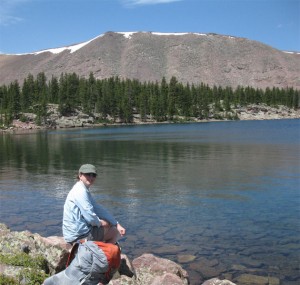
Farmer’s Lake, one of the larger lakes you will see at this altitude.
Farmer’s is ensconsed by high crummy rock walls on three sides and a steep shoreline with thick trees. We couldn’t see many good places to camp, so after taking a breather and watching a trout swim in the clear water, we headed east to some smaller lakes.
We found a wide open meadow leading to Lake 10,919, one of the lakes scattered along the eastern side of the Farmer’s Lake Basin. Even at this elevation, the heat beat down relentlessly, approaching nearly 90 degrees. Even the sharp mountain breeze did little to refresh us as it just seemed to blow more heat at us.
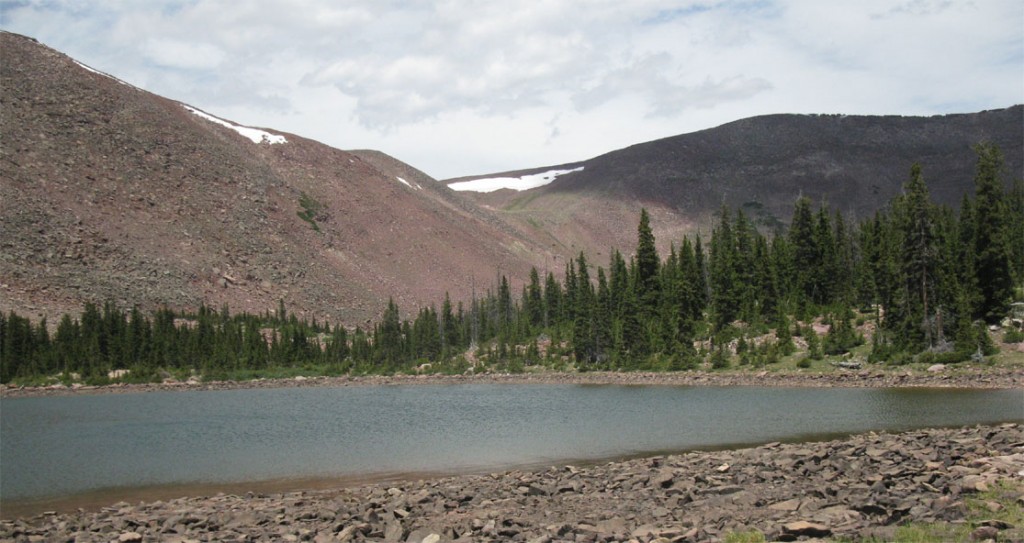
Unnamed Lake 10,919 just east of Farmers. Bluebell pass is in the saddle in the background of the picture.
The wind did at least keep the mosquitos at bay and we were content to just sit on a rock near the lake and talk with our friends who had gone up to the lake the day before. I took that beer out of the top hatch of my pack and stashed it in a shallow pool along the shore. I knew it would probably get colder out deeper in the lake, but I also had a slight concern that it might float away, or get poached by some thirsty bear. 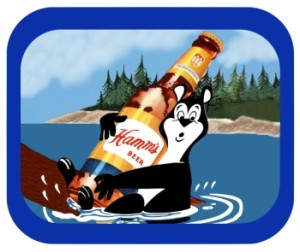 I know from the commercials of my youth bears prefer Hamms, but in this heat, I’m sure they’re not picky.
I know from the commercials of my youth bears prefer Hamms, but in this heat, I’m sure they’re not picky.
Most of the afternoon was spent sitting around in a state of absolute equanimity. We ate lunch, set up camp and even waded into the lake a little to cool off. I actually submerged myself in a short, painful baptism of refreshment, but over a days worth of sweat, salt, bug juice and sun screen needed to be stripped and the brief cooling of my body temperature felt great. Then I walked through the shin deep water over to my alpine cooler and grabbed the SanTan Devil’s Ale that had now reached a drinkable temperature.
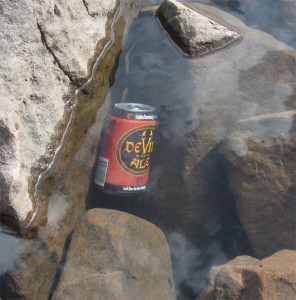
“Warm beer, meet mountain lake.”
Sitting on a rock with my shirt off and staring up at the seemingly endless rounded ridge that surrounded us seemed like one of the best summitBrews I’ve had, even if it wasn’t on a summit. I had thought about hiking up to Bluebell Pass and scrambling to one of the highpoints above the saddle for a true summitBrew, but given the oven like temperatures and the steep, loose talus that led to the top, I felt quite content to sit by a lake with my beer.
Devil’s Ale is a west coast pale brewed by SanTan in Chandler, Arizona. Established in 2007 as a brew pub that prides itself in quality food, their beer has only been distributed since 2009. Their motto is “Craft beer for beer drinking”. I’m not sure if they are jabbing at pretentious craft breweries, but I won’t argue with their claim… it is a craft beer… and I did drink it. Devil’s Ale has an amber color with a light head and a medium amount of carbonation. Its medium malt body holds a faint aroma and little character in the hops. The light hop taste quickly recedes amongst the more prevalent dry notes. 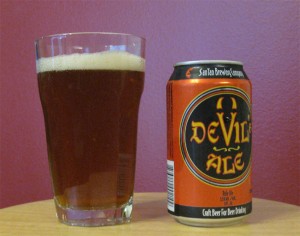 The 5.5 ABV beer that scores 45 on the IBU scale was quite refreshing at 11,000’. This beer did win gold at the 2011 Arizona Brew Festival, and while enjoyable, I have had a hard time finding any Arizona beers I can really light up about. This beer would probably fall into the category of, “not bad for an AZ beer”. I’ll probably go for a Lumberyard or Mudshark Full Moon if I was drinking the beers of the Grand Canyon State.
The 5.5 ABV beer that scores 45 on the IBU scale was quite refreshing at 11,000’. This beer did win gold at the 2011 Arizona Brew Festival, and while enjoyable, I have had a hard time finding any Arizona beers I can really light up about. This beer would probably fall into the category of, “not bad for an AZ beer”. I’ll probably go for a Lumberyard or Mudshark Full Moon if I was drinking the beers of the Grand Canyon State.
While there are numerous lakes to visit in the Uintas, I’ve found that the less visited lakes can often be the most enjoyable. In fact, I debated whether I even wanted to release the whereabouts of this summitBrew for fear of crowding a relatively unknown area. However, I’m pretty confident that Amethyst Basin, Kings Peak and Mirror Lake will still see the majority of Uinta traffic. With some of the most stunning scenery in the range, there is a very good reason those places are so popular, and I’m sure I’ll find myself hiking in anyone of those areas at some point, but in a range as vast and high as the Uintas, there will be more than a lifetime’s worth of summitBrews to be discovered.
 Big Mountain. The name suggests a massive massif, when it’s really just a small peak (8,472 feet) among much larger high points of the Wasatch. But while the mountain doesn’t quite live up to its name, the history of the place makes this sub-standard summit more than worthy of a quick morning hike, especially with a beer in tow, like New Belgium’s Red Hoptober.
Big Mountain. The name suggests a massive massif, when it’s really just a small peak (8,472 feet) among much larger high points of the Wasatch. But while the mountain doesn’t quite live up to its name, the history of the place makes this sub-standard summit more than worthy of a quick morning hike, especially with a beer in tow, like New Belgium’s Red Hoptober. The trail meandered here through scrub oak and bushes, but soon emerged just below the peak. It seemed an easy task to just clamber up the side of the mountain from here, but the trail did curve around to the north before an easy, less steep option revealed itself that went directly to the top.
The trail meandered here through scrub oak and bushes, but soon emerged just below the peak. It seemed an easy task to just clamber up the side of the mountain from here, but the trail did curve around to the north before an easy, less steep option revealed itself that went directly to the top.



